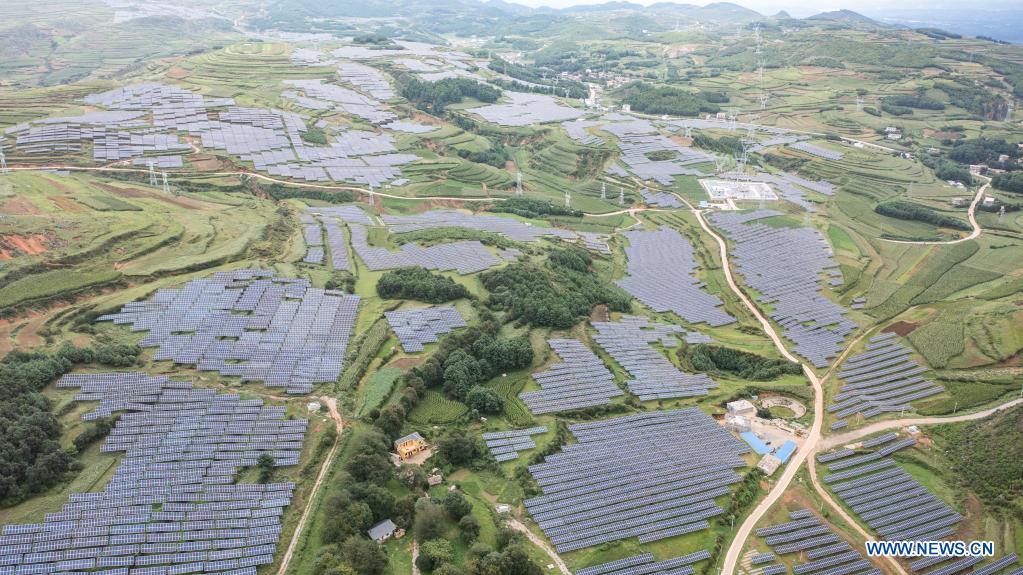China’s central SOEs make big contributions to rural vitalization
China’s centrally administered state-owned enterprises (SOEs) have contributed significantly to the country’s implementation of its rural vitalization strategy through a variety of measures.

Aerial photo taken on Aug. 24, 2021 shows a photovoltaic power station in Weining Yi, Hui and Miao Autonomous County, Bijie, southwest China's Guizhou Province. (Xinhua/Tao Liang)
Since this year, the central SOEs have actively participated in the development of infrastructure in rural areas, such as transportation, water conservancy, electricity, gas, and communications, to help address shortcomings in these fields, under the guidance of the State-owned Assets Supervision and Administration Commission of the State Council.
In Kunniushan, a mountain village in Tongren city of southwest China’s Guizhou Province, the Guizhou branch of China Southern Power Grid Corporation (CSG) upgraded the village’s power grid in 2018. This year, the branch invested 2.42 million yuan (about $379,995) in a power grid 400V extension project in the village to meet rising electricity demand due to the booming tourism and farming sectors. The extension project is one of more than 8,000 projects that aim to upgrade power grids in rural areas in Guizhou this year.
The CSG plans to build nine demonstration counties for modern rural power grids, 13 demonstration zones for power transmission networks, 11 demonstration villages (townships) for comprehensive energy services and 20 electrification demonstration villages across the country by 2025. The central SOE also aims to boost the development of featured industries in rural areas by further developing new electric power systems by 2035.
In north China’s Inner Mongolia Autonomous Region, the Inner Mongolia branch of State Power Investment Corporation (SPIC) had completed the construction of the first batch of a distributed photovoltaic (PV) demonstration project as of late November. Under the project, all 30 households had installed PV power systems on their rooftops, and 27 of them had been connected to the state power grid.
Li Qingshan, a farmer in a village in Baolongshan township, Tongliao city of the autonomous region, is one of those who has benefited from the demonstration project. By renting out his backyard to the SPIC branch, Li gets a rental revenue from the company. “The rent is much more than my previous income from growing crops in the courtyard,” Li said.
The company’s rooftop PV power generation system at Li’s home has a total installed capacity of 48.15 kilowatts and is expected to generate over 73,000 kWh of electricity a year, which is equivalent to reducing carbon dioxide emissions by 48.18 tons per year.
The SPIC branch is expected to complete the construction of the second phase of the project, which will see 3,000 households installing distributed PV power systems, by the end of this year.
In addition to the PV power project in Inner Mongolia, the SPIC has used clean energy for winter heating in Guinan county and Gonghe county in northwest China’s Qinghai Province. At the beginning of this year, it drew up a plan to build a long-term mechanism for rural vitalization, and has achieved positive results in promoting green electricity and rural vitalization.
China Unicom, one of the country’s largest telecom operators, has made continuous efforts to build the next-generation information infrastructure in rural areas, such as building 1,000M fiber optic networks. It aims to enable major townships across the country to have access to 1,000M fiber optic networks by 2025.
Starting from December 2020, Shangdong Unicom, a China Unicom subsidiary in east China’s Shandong Province, turned Xili village in Ji’an city into a village with full 5G network coverage and 1,000M fiber optic networks in a period of several months.
Meanwhile, central SOEs have also applied new technologies to help farmers solve a range of problems. China Unicom has launched a cloud platform for sheep breeding to address problems such as inefficient management of sheep.
The company installed intelligent devices, which are connected with the smart platform, in a sheep breeding base in Xianong village, Ganxian district, Ganzhou city, east China’s Jiangxi Province. Each sheep wears a special ear tag with a built-in 5G chip, enabling employees at the base to immediately obtain the unique identification information on the sheep, such as its sex, age, and immunization, by scanning its ear tag. They can also adjust the amount of fodder, temperature and humidity as well as the concentration of ammonia at the base at any time through the smart platform.
At present, six small and medium-sized sheep farms in the county have benefited from China Unicom’s smart platform, bringing prosperity to over 100 farmers.
Photos
Related Stories
- Granting professional titles to self-taught experts gives impetus to rural vitalization in China
- Saffron crocus planting industry leads town in E China’s Zhejiang to prosperity
- China rolls out multiple measures to enrich rural residents’ cultural life
- Vocational training helps boost rural vitalization in Xinjiang: residents
- Hangzhou City in Zhejiang promotes handmade dried noodles to develop agricultural, rural tourism industries
- E-commerce heralds prosperity in remote south China village
Copyright © 2021 People's Daily Online. All Rights Reserved.










